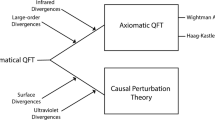Abstract
Both gravitons and pions are described by non-linear and non-renormalizable actions at low energies. These are most usefully treated by effective field theory, which is a full quantum field theoretic approach that relies only on the low-energy degrees of freedom and their interactions. The gravitational case is particularly clean because of the masslessness of the graviton and the wide separation of scales. This essay provides an overview of this approach.



Similar content being viewed by others
Data Availability Statement
This manuscript has no associated data or the data will not be deposited. [Authors’ comment: This paper describes theoretical research and there is no data associated with this research.]
Notes
I am being somewhat unfair here. There was also a tradition of using dispersive techniques which in principle are fully rigorous. But in practice one had to make various approximations in applying dispersion relations to complex problems, and so also here the reliability was suspect. Dispersive techniques have been married to effective field theory successfully enhancing the power of both.
Of course, effective field theory can also be used as a simplification of a known theory. The same rules apply, but the coefficients in this case can be known from matching to the full theory.
As a sociological observation related to the BJ story at the start of this essay, I would also note that the differences between these variants of nuclear EFTs seemed to bring out the religious fervor of many participants.
The gravitational effective field theory has fewer parameters than the pionic one, because gravitons couple to the energy momentum tensor, which is independently known.
References
J.F. Donoghue, E. Golowich, B.R. Holstein, Dynamics of the standard model. Camb. Monogr. Part. Phys. Nucl. Phys. Cosmol. 2, 1 (1992)
J.F. Donoghue, E. Golowich, B.R. Holstein, Dynamics of the standard model. Camb. Monogr. Part. Phys. Nucl. Phys. Cosmol. 35 (2014). https://doi.org/10.1017/CBO9780511524370
H.B. Nielsen, N. Brene, Standard model group: survival of the fittest. Nucl. Phys. B 224, 396 (1983). https://doi.org/10.1016/0550-3213(83)90382-6
R.P. Feynman, Quantum theory of gravitation. Acta Phys. Polon. 24, 697 (1963)
B.S. DeWitt, Quantum theory of gravity. 2. The manifestly covariant theory. Phys. Rev. 162, 1195 (1967). https://doi.org/10.1103/PhysRev.162.1195
J.F. Donoghue, M.M. Ivanov, A. Shkerin, EPFL lectures on general relativity as a quantum field theory. arXiv:1702.00319 [hep-th]
M.J.G. Veltman, Quantum theory of gravitation. Conf. Proc. C 7507281, 265 (1975)
G. Hooft, M.J.G. Veltman, One loop divergencies in the theory of gravitation. Ann. Inst. H. Poincare Phys. Theor. A 20, 69 (1974)
M.H. Goroff, A. Sagnotti, Quantum gravity at two loops. Phys. Lett. B 160, 81 (1985). https://doi.org/10.1016/0370-2693(85)91470-4
J.F. Donoghue, General relativity as an effective field theory: the leading quantum corrections. Phys. Rev. D 50, 3874 (1994). https://doi.org/10.1103/PhysRevD.50.3874. arXiv:gr-qc/9405057
N.E.J. Bjerrum-Bohr, J.F. Donoghue, B.R. Holstein, Quantum gravitational corrections to the nonrelativistic scattering potential of two masses. Phys. Rev. D 67, 084033 (2003) [Erratum: Phys. Rev. D 71, 069903 (2005)] https://doi.org/10.1103/PhysRevD.71.069903. https://doi.org/10.1103/PhysRevD.67.084033. arXiv:hep-th/0211072
I.B. Khriplovich, G.G. Kirilin, Quantum power correction to the Newton law. J. Exp. Theor. Phys. 95(6), 981 (2002)
I.B. Khriplovich, G.G. Kirilin, Quantum power correction to the Newton law. Zh. Eksp. Teor. Fiz. 122(6), 1139 (2002). https://doi.org/10.1134/1.1537290. arXiv:gr-qc/0207118
N.E.J. Bjerrum-Bohr, J.F. Donoghue, P. Vanhove, On-shell techniques and universal results in quantum gravity. JHEP 1402, 111 (2014). https://doi.org/10.1007/JHEP02(2014)111. arXiv:1309.0804 [hep-th]
N.E.J. Bjerrum-Bohr, J.F. Donoghue, B.R. Holstein, L. Planté, P. Vanhove, Bending of light in quantum gravity. Phys. Rev. Lett. 114(6), 061301 (2015). https://doi.org/10.1103/PhysRevLett.114.061301. arXiv:1410.7590 [hep-th]
N.E.J. Bjerrum-Bohr, J.F. Donoghue, B.R. Holstein, L. Plante, P. Vanhove, Light-like scattering in quantum gravity. JHEP 1611, 117 (2016). https://doi.org/10.1007/JHEP11(2016)117. arXiv:1609.07477 [hep-th]
D. Bai, Y. Huang, More on the bending of light in quantum gravity. Phys. Rev. D 95(6), 064045 (2017). https://doi.org/10.1103/PhysRevD.95.064045. arXiv:1612.07629 [hep-th]
H.H. Chi, Graviton bending in quantum gravity from one-loop amplitudes. Phys. Rev. D 99(12), 126008 (2019). https://doi.org/10.1103/PhysRevD.99.126008. arXiv:1903.07944 [hep-th]
J.D. Bjorken, The future of particle physics. Int. J. Mod. Phys. A 16, 483 (2001). https://doi.org/10.1142/S0217751X01003226. arXiv:hep-ph/0006180
T. Damour, J.F. Donoghue, Constraints on the variability of quark masses from nuclear binding. Phys. Rev. D 78, 014014 (2008). https://doi.org/10.1103/PhysRevD.78.014014. arXiv:0712.2968 [hep-ph]
J.F. Donoghue, The multiverse and particle physics. Annu. Rev. Nucl. Part. Sci. 66, 1 (2016). https://doi.org/10.1146/annurev-nucl-102115-044644. arXiv:1601.05136 [hep-ph]
E. Epelbaum, U.G. Meissner, W. Gloeckle, Nuclear forces in the chiral limit. Nucl. Phys. A 714, 535 (2003). https://doi.org/10.1016/S0375-9474(02)01393-3. arXiv:nucl-th/0207089
E. Epelbaum, W. Gloeckle, U.G. Meissner, Improving the convergence of the chiral expansion for nuclear forces. 1. Peripheral phases. Eur. Phys. J. A 19, 125 (2004). https://doi.org/10.1140/epja/i2003-10096-0. arXiv:nucl-th/0304037
C. Ordonez, L. Ray, U. van Kolck, The Two nucleon potential from chiral Lagrangians. Phys. Rev. C 53, 2086 (1996). https://doi.org/10.1103/PhysRevC.53.2086. arXiv:hep-ph/9511380
S.R. Beane, M.J. Savage, The quark mass dependence of two nucleon systems. Nucl. Phys. A 717, 91 (2003). https://doi.org/10.1016/S0375-9474(02)01586-5. arXiv:nucl-th/0208021
J.F. Donoghue, The nuclear central force in the chiral limit. Phys. Rev. C 74, 024002 (2006). https://doi.org/10.1103/PhysRevC.74.024002. arXiv:nucl-th/0603016
J.F. Donoghue, Sigma exchange in the nuclear force and effective field theory. Phys. Lett. B 643, 165 (2006). https://doi.org/10.1016/j.physletb.2006.10.033. arXiv:nucl-th/0602074
B. Long, U. van Kolck, Renormalization of singular potentials and power counting. Ann. Phys. 323, 1304 (2008). https://doi.org/10.1016/j.aop.2008.01.003. arXiv:0707.4325 [quant-ph]
H. Leutwyler, Model independent determination of the sigma pole. AIP Conf. Proc. 1030(1), 46 (2008). https://doi.org/10.1063/1.2973552. arXiv:0804.3182 [hep-ph]
R.J. Furnstahl, B.D. Serot, Parameter counting in relativistic mean field models. Nucl. Phys. A 671, 447 (2000). https://doi.org/10.1016/S0375-9474(99)00839-8. arXiv:nucl-th/9911019
Acknowledgements
I would like to thank the organizers and participants at the workshop “The tower of the effective field theories and the emergence of the nuclear phenomena” (January 2017, CEA Saclay) for lively discussions, most particularly U. Meissner, U. van Kolck and P. Vanhove. I also thank J. Bjorken for confirming the story used in the introduction. This work has been supported in part by the National Science Foundation under grant NSF PHY15-20292 and PHY18-20675
Author information
Authors and Affiliations
Corresponding author
Additional information
Communicated by T. Duguet
Rights and permissions
About this article
Cite this article
Donoghue, J.F. Gravitons and pions. Eur. Phys. J. A 56, 86 (2020). https://doi.org/10.1140/epja/s10050-020-00091-2
Received:
Accepted:
Published:
DOI: https://doi.org/10.1140/epja/s10050-020-00091-2



